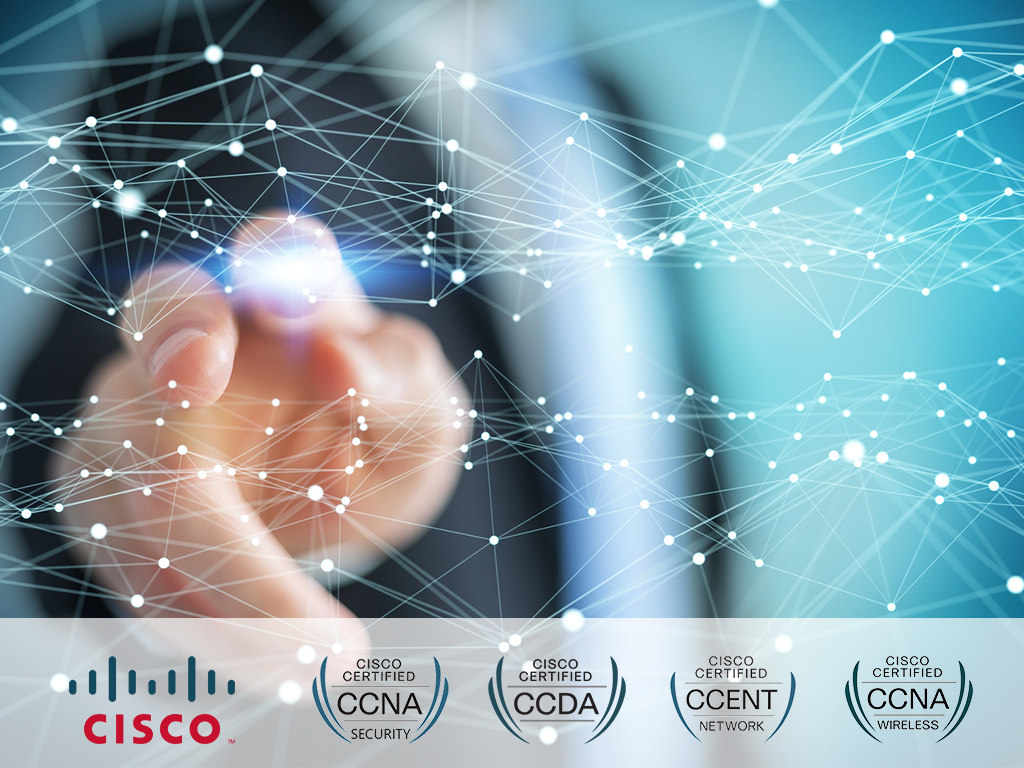Cisco Design Exam 352-001
352-001 CCDE Written & Practical Exam

The Cisco Design Exam 352-001 Written Exam will test a candidate’s combined knowledge of routing protocols, internetworking theory, and design principles.
The exam assesses a candidate’s understanding of network design in the areas of routing, tunneling, Quality of Service, Management, Cost, Capacity, and Security.
Cisco Design Exam 352-001 combines in-depth technical concepts with Network Design principles.
An Evolving Technologies section is included in the Written exam only.
It will enable candidates to bridge their core technology expertise with knowledge of the evolving technologies.
these technologies are being adopted at an accelerated pace, such as cloud, IoT, and network programmability.
Cisco CCDE® Written Exam tests a candidate’s combined knowledge of routing protocols, internetworking theory, and design principles.
It assesses a candidate’s understanding of network design in the areas of routing, tunneling, Quality of Service, Management, Cost, Capacity, and Security.
Cisco Design Exam 352-001 combines in-depth technical concepts with Network Design principles.
Product-specific knowledge including a version of code, implementation, and operations specific concepts are not tested on the CCDE exam.
The exam is closed book and no outside reference materials are allowed.

An Evolving Technologies section is included in the Written exam only.
It will enable candidates to bridge their core technology expertise with knowledge of the evolving technologies
these technologies are being adopted at an accelerated pace, such as cloud, IoT, and network programmability.
It has been recalibrated and will consist of three subdomains and a total of five tasks for which the expected depth of knowledge will be focused on conceptual comprehension.
The Evolving Technologies section will account for 10 percent of the total score while the remaining core technologies will account for 90 percent.
The following topics are general guidelines for the content likely to be included on the Cisco Design Exam 352-001.
However, other related topics may also appear on any specific delivery of the exam.
In order to better reflect the contents of the exam and for clarity purposes, the guidelines below may change at any time without notice.
1.0 Layer 2 Control plane 24%
1.1 Describe fast convergence techniques and mechanisms
- 1.1.a Down detection
- 1.1.b Interface dampening
1.2 Describe loop detection and mitigation protocols
- 1.2.a Spanning tree types
- 1.2.b Spanning tree tuning techniques
1.3 Describe mechanisms that are available for creating loop-free topologies
- 1.3.a REP
- 1.3.b Multipath
- 1.3.c Switch clustering
- 1.3.d Flex links
- 1.3.e Loop detection and mitigation
1.4 Describe the effect of transport mechanisms and their interaction with routing protocols over different types of links
1.5 Describe multicast routing concepts
1.6 Describe the effect of fault isolation and resiliency on network design
- 1.6.a Fault isolation
- 1.6.b Fate sharing
- 1.6.c Redundancy
- 1.6.d Virtualization
- 1.6.e Segmentation

2.0 Layer 3 Control Plane 33%
2.1 Describe route aggregation concepts and techniques
- 2.1.a Purpose of route aggregation
- 2.1.b When to leak routes / avoid suboptimal routing
- 2.1.c Determine aggregation location and techniques
2.2 Describe the theory and application of network topology layering
- 2.2.a Layers and their purposes in various environments
2.3 Describe the theory and application of network topology abstraction
- 2.3.a Purpose of link state topology summarization
- 2.3.b Use of link state topology summarization
2.4 Describe the effect of fault isolation and resiliency on network design or network reliability
- 2.4.a Fault isolation
- 2.4.b Fate sharing
- 2.4.c Redundancy
2.5 Describe metric-based traffic flow and modification
- 2.5.a Metrics to modify traffic flow
- 2.5.b Third-party next hop
2.6 Describe fast convergence techniques and mechanisms
- 2.6.a Protocol timers
- 2.6.b Loop-free alternates
2.7 Describe factors affecting convergence
- 2.7.a Recursion
- 2.7.b Microloops
- 2.7.c Transport
2.8 Describe unicast routing protocol operation [OSPF, EIGRP, ISIS, BGP, and RIP] in relation to network design
- 2.8.a Neighbor relationships
- 2.8.b Loop-free paths
- 2.8.c Flooding domains and stubs
- 2.8.d iBGP scalability
2.9 Analyze operational costs and complexity
- 2.9.a Routing policy
- 2.9.b Redistribution methods
2.10 Describe the interaction between routing protocols and topologies
2.11 Describe generic routing and addressing concepts
- 2.11.a Policy-based routing
- 2.11.b NAT
- 2.11.c Subnetting
- 2.11.d RIB-FIB relationships
2.12 Describe multicast routing concepts
- 2.12.a General multicast concepts
- 2.12.b Source specific
- 2.12.c MSDP/anycast
- 2.12.d PIM
- 2.12.e mVPN
2.13 Describe IPv6 concepts and operation
- 2.13.a General IPv6 concepts
- 2.13.b IPv6 security
- 2.13.c IPv6 transition techniques

3.0 Network Virtualization 15%
3.1 Describe Layer 2 and Layer 3 tunnelling technologies
- 3.1.a Tunnelling for security
- 3.1.b Tunnelling for network extension
- 3.1.c Tunnelling for resiliency
- 3.1.d Tunnelling for protocol integration
- 3.1.e Tunnelling for traffic optimization
3.2 Analyze the implementation of tunnelling
- 3.2.a Tunnelling technology selection
- 3.2.b Tunnelling endpoint selection
- 3.2.c Tunnelling parameter optimization of end-user applications
- 3.2.d Effects of tunnelling on routing
- 3.2.e Routing protocol selection and tuning for tunnels
4.0 Design Considerations 18%
4.1 Analyze various QoS performance metrics
- 4.1.a Application requirements
- 4.1.b Performance metrics
4.2 Describe types of QoS techniques
- 4.2.a Classification and marking
- 4.2 b Shaping
- 4.2.c Policing
- 4.2.d Queuing
4.3 Identify QoS strategies based on customer requirements
- 4.3.a DiffServ
- 4.3.b IntServ
4.4 Identify network management requirements
4.5 Identify network application reporting requirements
4.6 Describe technologies, tools, and protocols that are used for network management
4.7 Describe the reference models and processes that are used in network management, such as FCAPS, ITIL®, and TOGAF
4.8 Describe best practices for protecting network infrastructure
- 4.8.a Secure administrative access
- 4.8.b Control plane protection
4.9 Describe best practices for protecting network services
- 4.9.a Deep packet inspection
- 4.9.b Data plane protection
4.10 Describe tools and technologies for identity management
4.11 Describe tools and technologies for IEEE 802.11 wireless deployment
4.12 Describe tools and technologies for optical deployment
4.13 Describe tools and technologies for SAN fabric deployment
5.0 Evolving Technologies V1.1 10%
- 5.1 Cloud
- 5.1.a Compare and contrast public, private, hybrid, and multi-cloud design considerations
- 5.1.a [i] Infrastructure, platform, and software as a service (XaaS)
- 5.1.a [ii] Performance, scalability, and high availability
- 5.1.a [iii] Security implications, compliance, and policy
- 5.1.a [iv] Workload migration
- 5.1.b Describe cloud infrastructure and operations
- 5.1.b [i] Compute virtualization (containers and virtual machines)
- 5.1.b [ii] Connectivity (virtual switches, SD-WAN and SD-Access)
- 5.1.b [iii] Virtualization functions (NFVi, VNF, and L4/L6)
- 5.1.b [iv] Automation and orchestration tools (CloudCenter, Cisco DNA-center, and Kubernetes)5.2 Network programmability (SDN)
- 5.2.a Describe architectural and operational considerations for a programmable network
- 5.2.a [i] Data models and structures (YANG, JSON and XML)
- 5.2.a [i] Device programmability (gRPC, NETCONF and RESTCONF)
- 5.2.a [ii] Controller based network design (policy-driven configuration and northbound/ southbound APIs)
- 5.2.a [iii] Configuration management tools (agent and agentless) and version control systems (Git and SVN)5.3 Internet of things (IoT)
- 5.3.a Describe architectural framework and deployment considerations for IoT
- 5.3.a [i] IoT technology stack (IoT Network Hierarchy, data acquisition, and flow)
- 5.3.a [ii] IoT standards and protocols (characteristics within IT and OT environment)
- 5.3.a [iii] IoT security (network segmentation, device profiling, and secure remote)

CCDE Practical Exam (Cisco Design Exam 352-001)
The Cisco Design Exam 352-001 Practical Exam is an 8-hour, scenario-based design exam.
That will assess your ability to analyze design requirements, develop network designs, justify design decisions, and validate and optimize a network design.
The exam will assess your ability to apply your specific body of knowledge to current business problems of technical network design.
Product-specific knowledge including a version of code, implementation, and operations specific concepts is not tested on the CCDE exam.
Only candidates that have a passing score on the CCDE Written Exam may register for the CCDE Practical Exam.
The topics that are covered in the CCDE Practical Exam are located within the exam topics.
Cisco Design Exam 352-001 scenarios may change in each instance that the exam is delivered; however, the topics will remain the same.
Cisco Design Exam 352-001 Practical Exam Description
Cisco CCDE® Practical Exam is an 8-hour, scenario-based exam.
That will validate that professionals have the expertise to gather and clarify network functional requirements.
so, they can develop network designs to meet functional specifications, develop an implementation plan, convey design decisions and their rationale, and possess expert-level network infrastructure knowledge.
The exam is closed book, and no outside reference materials are allowed.
The following topics are general guidelines for the content likely to be included on the exam.
However, other related topics may also appear on any specific delivery of the exam.
In order to better reflect the contents of the exam and for clarity purposes, the guidelines below may change at any time without notice.
1.0 Analyze Design Requirements 36%
1.1 Analyze business requirements, conflicts, and constraints
- 1.1.a OPEX and CAPEX
- 1.1.b Project goals
- 1.1.c Lifecycle and return on investment (ROI)
- 1.1.d Business environment
- 1.1.e Compliance and policy
1.2 Analyze technical requirements, conflicts, and constraints
- 1.2.a Application requirements
- 1.2.b Compliance and policy
1.3 Analyze physical requirements
- 1.3.a Topology implications
- 1.3.b Operational requirements
- 1.3.c Analyze business and technical risks
1.4 Analyze existing network
- 1.4.a Network documentation
- 1.4.b Network infrastructure and its effect on network design
2.0 Develop Network Designs 39%
2.1 Identify the technology to resolve a specific design problem
- 2.1.a Functional specifications
- 2.1.b Network designs
- 2.1.c Operational considerations
2.2 Analyze the effect on the existing network and services
- 2.2.a Functional specifications
- 2.2.b Network designs
- 2.2.c Operational considerations
2.3 Incorporate best practices within the network design
- 2.3.a Avoidance of over-engineering
- 2.3.b Consistent and modularized solution sets throughout the network
- 2.3.c Industry best practices
2.4 Incorporate business requirements within the network design
- 2.4.a OPEX and CAPEX
- 2.4.b Lifecycle and return on investment (ROI)
- 2.4.c Compliance and policy
3.0 Implement Network Design 13%
3.1 Analyze implementation options
- 3.1.a Effect on design
- 3.1.b Effect on performance, availability, and network management
- 3.1.c Effect on the business
- 3.1.d Risk and consequence for a given implementation plan
3.2 Design an implementation plan
- 3.2.a Interdependencies between services, failure domains, and other architectural elements
- 3.2.b Implementation timeline and steps
- 3.2.c Contingency plans for network restoration
4.0 Validate and Optimize Network Design 12%
4.1 Analyze design choices based on specifications
- 4.1.a Effect of implementing changes to the original design
- 4.1.b Effect of different design solutions created by new drivers
4.2 Validate design
- 4.2.a Test strategy
- 4.2.b Performance metrics and baselines
4.3 Optimize design
- 4.3.a KPI
- 4.3.b Baselines
Cisco Design Exam 352-001